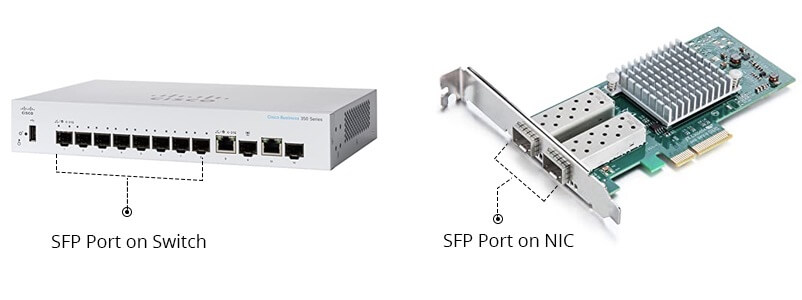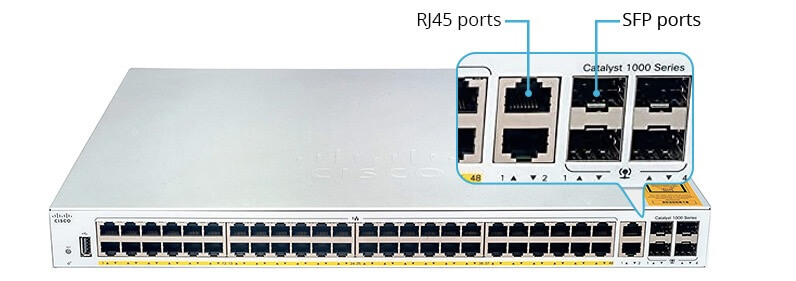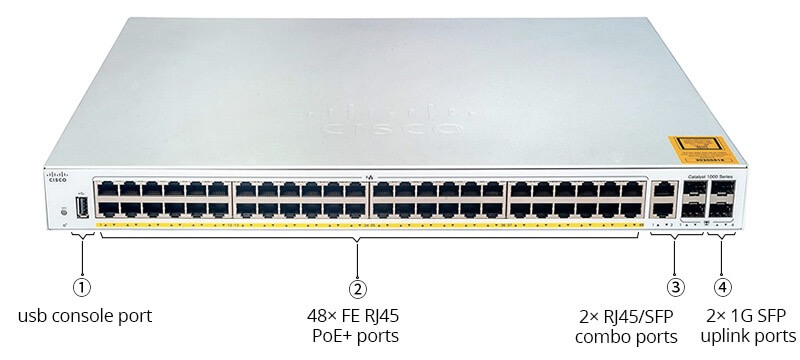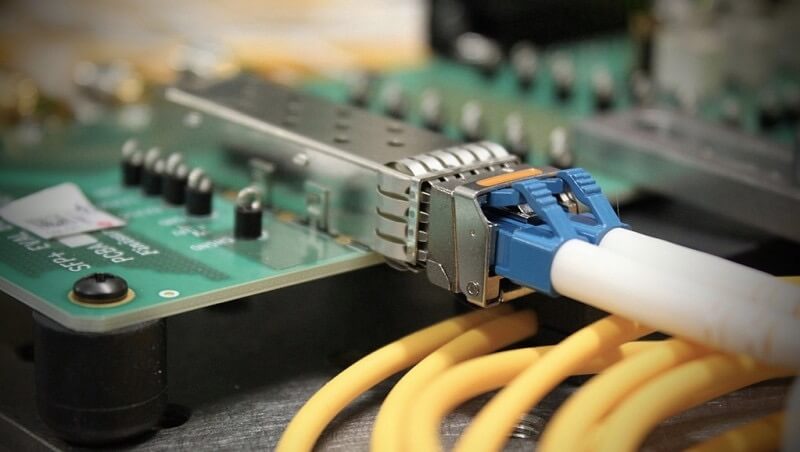If you’ve ever connected devices using cables, you might have come across an SFP port. These small slots do a lot of important work in data communications. An SFP port is a tiny slot in a device that takes in an SFP module. Many modern devices like switches, servers, and routers have two or more of these SFP ports. When you attach the port, you can link switches using SFP modules and cables. This gives you better bandwidth and a faster network.
What is an SFP Port?
An SFP port is a slot on a computer or network device where you can insert small form-factor pluggable (SFP) transceivers. With this port, you can connect lots of switches using SFP modules and cables. This helps make the network faster and handle more data. It is an easy plug-and-play solution to your pre-terminated fiber optic assembly.
SFP Port Locations
An SFP port is on devices like switches, servers, routers, or network cards in computers. Big computer networks often have switches with at least two SFP ports. These switches might also be called SFP switches.

SFP Port Function
On networking equipment, the SFP port is a small slot that accommodates an SFP module insert. An SFP port helps two devices send data to each other using an SFP transceiver and the right cables. To put it simply, the port and its matching SFP transceiver help the two devices communicate with each other even if they’re quite far apart.


Importance of SFP Ports in Networking
SFP ports are crucial due to their ability to deliver high bandwidth, optimize space, offer flexibility, and provide cost-effective solutions in modern network setups.
- Maximizing Bandwidth: High-speed network switches primarily rely on fiber ports for maximum bandwidth over long distances. Copper cables can’t match the speed and distance capability of fiber, making fiber essential for efficient data transmission.
- Space and Efficiency: Fiber ports are crucial for modern Ethernet switches as they serve as a bridge between transceivers and switches. They enable signals to travel even hundreds of kilometers over fiber cables. Their compact SFP form factor allows more ports in the same space, enhancing efficiency.
- Flexibility and Ease: SFP ports are hot-pluggable, enabling swift replacement of SFP modules without switching off the entire system. This is ideal for network expansion or modifications without disrupting the existing cable setup.
- Cost-Effective Choice: The popularity of the SFP form factor results in a wide variety of vendors and options, leading to competitive pricing. Switch manufacturers can find reliable suppliers at lower costs, ultimately making networking devices more affordable and expanding the market.
SFP Port Applications
Generally, SFP ports are used to connect networking devices to fiber optic or copper cables, such as switches, routers, and network interface cards (NICs). SFP ports and their matching modules are used to create fast, seamless data connections over long distances in various situations. They’re often used to connect one-gigabit network switches, making networks more capable and efficient. This is handy in industrial, commercial, and military setups where lots of equipment require a speedy connection across a wide area.
SFP Port vs RJ45 Port
Let’s start by understanding the basics of an RJ45 port, as this knowledge will help you grasp the distinctions among different types of SFP ports more effectively.
Apart from SFP ports, Gigabit switches commonly feature built-in RJ45 ports that facilitate easy connections using Ethernet copper cables. Now, let’s delve into the contrasts between SFP ports and RJ45 ports on a Gigabit switch.

| Features | SFP Port | RJ45 Port |
| Connection Types | Copper SFP module + RJ45 Ethernet cable (Cat5e/Cat6 or higher) | RJ45 Ethernet cable (Cat5e/Cat6 or higher) |
| Fiber SFP module + fiber optic cable (SMF fiber / MMF fiber) | ||
| Max Distance | MMF (550m) / SMF (150km) / RJ45 Ethernet cable (100m) | 100m (330ft) |
| Data Rate | 1000Mbps (1G) | 1000Mbps (1G) |
SFP Port Types
We can categorize them according to different functions.

SFP Combo Ports
A combo port, also called an optoelectronic multiplexing interface, is a unique port found on Ethernet switches. It combines two types of Ethernet interfaces – the RJ45 port and the SFP port – within a single port on the switch panel.
In simpler terms, a combo port serves as a single interface with two usable ends. It’s a compound physical aperture that connects to the correct Ethernet port via the same Lan switch fabric and port number. In other words, it serves the same functions as another physical port (mainly as a 1000BASE-T RJ45 port). It supports both copper connections (via the RJ45 port) and optical connections (via the SFP port). This means you have the flexibility to use either the RJ45 port or the SFP port based on your needs.
However, it’s important to note that these two different SFP ports cannot be active simultaneously. Each combo port provides a choice between two connections: one for a copper Ethernet cable using the RJ45 port, and the other for a fiber optic cable using the SFP port. For instance, in a Gigabit switch with a combo SFP port, you have to choose between using the corresponding copper port or the SFP port; both can’t be used at the same time.
SFP Uplink Ports
To grasp the concept of uplink ports, it’s important to familiarize yourself with common switch types and port classifications. Networks follow a hierarchical model comprising the core, distribution, and access layers, each facilitated by specific switch types: core switch, distribution switch, and access switch. These switches serve distinct functions within the network. Additionally, network switches offer two main port categories: uplink ports and normal ports (downlink ports).
- Uplink Ports Explained: An uplink port, typically a higher-speed port, connects devices to higher-speed counterparts within the network topology or links smaller local networks to larger ones. Meanwhile, normal (downlink) ports are standard ports used for regular data transmission. Various port types include RJ45, SFP, SFP+, SFP28, QSFP+, and QSFP28, enabling network connections through fiber or network cables, with varying data rates and transmission distances.
- SFP Uplink Port Usage: An uplink SFP port is used for connecting to a higher layer in the network topology. This also means connecting to a higher speed switch such as 10G SFP+, 25G SFP28, 40G QSFP+, and 100G QSFP28. The SFP uplink port connects to the downlink port of higher-speed switches. In this setup, it acts as a lower-tier network, while the connected device functions as a higher network layer. For example, you might link the uplink port of a LAN switch to the downlink port of a higher-speed WAN switch, facilitated by transceiver modules and fiber patch cables.
- Important Note: Avoid attempting to connect two uplink ports, as this results in a failed link. Always double-check port types before merging devices to prevent errors.
SFP PoE Ports
Power over Ethernet (PoE) is a technology that lets you send both power and data through Ethernet cables. Think of it as a way to combine electricity and information in the same cable. An SFP PoE port is like a regular RJ45 port, but with the added ability to provide PoE. This lets PoE switches send both data and electricity to devices (like cameras or phones) using just one copper cable.
An SFP PoE port makes a PoE switch a data transmission device as well as power sourcing equipment (PSE). At home, you might have devices like TVs and laptops that can be powered using PoE. In offices, you can use PoE for things like VoIP phones, video calls, security cameras, and wireless access points.
FAQs about SFP Ports
Q: What’s the Farthest Distance for SFP Ports?
A: The farthest distance that SFP ports can cover when connecting two devices depends on the data transfer rate of the SFP module. This rate determines the type of cable used for the connection, which then affects the practical distance achievable.
Q: Does an SFP Port Use Copper or Fiber Optic Cables?
A: An SFP port can work with both copper and fiber optic cables. The choice between the two depends on the capabilities of the SFP transceiver.
Here’s the breakdown.
- Copper Cables: If your network requires data transfer rates up to 1 Gbps and covers distances of around 100 meters or less, you can use a regular Cat 6 Ethernet cable with your SFP. Traditional SFP modules support up to 1 Gbps, which aligns well with Cat 6 cables. This combination works effectively for such scenarios.
- Fiber Optic Cables: When you need faster data transfer rates, like 10 Gbps or 40 Gbps, or need to cover longer distances, you would opt for SFP+ or QSFP+ transceivers along with fiber optic cables. These transceivers allow for higher speeds and greater distances without compromising performance. While technically you could use higher-category Ethernet cables with SFP+ transceivers, the distance they can cover is limited to around 30 meters.
In summary, the choice between copper and fiber optic cables for an SFP port depends on your data transfer speed needs and the distance you want to cover.
Q: Can I Aggregate Multiple SFP Ports?
A: Absolutely, you can aggregate multiple SFP ports. Link aggregation brings numerous advantages such as increased bandwidth, redundancy, and load balancing. This setup allows swift switching to another available link if one fails. This feature is especially crucial for enterprise networks prioritizing performance and security.
Q: Can I Connect SFP Ports on Different Brand Switches?
A: In most cases, you can connect SFP ports across switches from different brands, but there’s a chance of errors if not done correctly. Here’s what you should keep in mind.
- Wavelength Consistency: Make sure to use SFP modules with the same wavelength in both slots. For BiDi (Bidirectional) transceiver modules, select opposite wavelengths for the two slots. Mismatched wavelengths can lead to connection failures.
- Compatibility Check: Always verify the compatibility of your switch and SFP module. Some big names like Cisco may block generic SFP transceivers.
- Quality Fiber Cables: Use proper, high-quality fiber cables. An incorrect choice can reduce the link distance or even lead to connection failures. Remember, MMF (Multimode Fiber) SFP transceivers work only with multimode fiber, while SMF (Single-Mode Fiber) transceivers are for single-mode fiber.
In summary, while connecting SFP ports from different brands is generally feasible, taking precautions regarding wavelength, compatibility, and fiber cables is essential to ensure a successful and reliable connection.
Conclusion
SFP ports play a vital role in high-speed data and telecommunications, particularly within expansive network setups. Keep in mind that the core purpose of an SFP port is to enable a dependable, high-speed connection between two devices using either copper or fiber optic cables. Thanks to the presence of SFP ports and their corresponding modules, you and your team can collaborate efficiently through remarkably swift and smooth connections. Check the small form factor pluggable SFP if you are interested.




